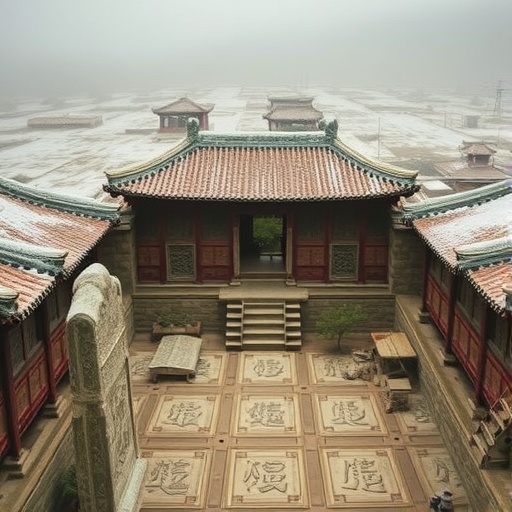Ancient tombs in China, dating back over four millennia to the Xia Dynasty, serve as a profound testament to the region’s illustrious historical narratives and cultural legacies. A recent study published in PLOS One unveils a comprehensive mapping of these burial sites, uncovering the patterns that emerge from their distribution throughout various historical epochs. Conducted by a team led by Quanbao Ma from Beijing University of Civil Engineering and Architecture, this research not only sheds light on the historical significance of these tombs but also explores the socioeconomic and geographical factors that have shaped their locations.
The findings of this study provide a fascinating lens through which to examine the evolution of burial practices in China. As the researchers meticulously cataloged the sites of ancient tombs, they observed distinct trends correlating with periods of relative political and economic stability. Significant numbers of these archaeological sites are from the Qin-Han and Yuan-Ming-Qing dynasties, eras characterized by social cohesion and prosperity. Conversely, tumultuous periods like the Five Dynasties era displayed a marked scarcity of tomb construction, indicating that socioeconomic stability directly influenced the investment in elaborate burial practices.
The research highlights the role of living standards in the construction of tombs, suggesting that, during times of stability and economic growth, people could focus more on their cultural practices surrounding death and the afterlife. When history is marred by conflict, such as the wars that ravaged northern China during the late Eastern Han dynasty through to the Northern and Southern dynasties, the patterns shift dramatically. The migration of populations to more peaceful southern regions during such unrest resulted in a concentrated clustering of tombs in these areas, painting a vivid picture of human adaptability amid societal upheaval.
The geographical analysis conducted in the study further elucidates the relationship between environment and tomb construction. The Chengdu-Chongqing and Central Plains regions stand out with a notable density of surviving tombs. Such regions, characterized by fertile soil, flat terrain, and ample water sources, provided ideal conditions for the establishment and sustenance of ancient settlements. Additionally, the favorable climatic conditions in these areas likely contributed to the preservation of artifacts, enabling modern researchers to glean insights from these ancient sites.
Burial sites are treasures of cultural heritage, serving as a reservoir of historical knowledge. They provide invaluable insights into the social structures, beliefs, and artistic practices of ancient societies. The meticulous documentation and analysis undertaken by the research team aim to illuminate the socio-historical contexts in which these tombs were built. This kind of systematic research establishes a critical foundation for ongoing conservation efforts, ensuring that these sites are protected for future generations to appreciate and study.
The overarching goal of this study extends beyond mere documentation. The authors aspire to create a robust framework for the scientific preservation of ancient tombs in China. By identifying specific patterns and conditions that influenced the locations and legacies of these burial sites, they advocate for a strategic approach to conservation, recognizing the need to preserve not just the physical tombs, but also the cultural narratives they encapsulate.
Moreover, the implications of this research resonate on a broader scale, inviting a reevaluation of how archaeological sites are perceived and valued in modern society. As urbanization and modernization continue to encroach upon these historical landscapes, the urgency to prioritize their conservation escalates. This research serves as a clarion call for increased awareness and investment in safeguarding cultural heritage sites against the threats posed by contemporary development.
As the team navigates the complexities of historical data and archaeological findings, their work highlights the potential for interdisciplinary collaboration in unraveling the past. The integration of technology, geographic information systems, and historical analysis equips researchers to create a more nuanced understanding of ancient cultural practices, weaving together the threads of archaeology, sociology, and history in a rich tapestry of knowledge.
The study also raises critical questions about the future of archaeological preservation. In a world where cultural heritage often takes a back seat to economic development, the balance between progress and preservation remains a contentious dialogue. Researchers must grapple with the ethics of site management, as stakes are high when it comes to decisions impacting irreplaceable historical sites.
Ultimately, the revelations drawn from the study concerning the characteristics and influencing factors of ancient tombs in China lay the groundwork for future investigations. They call for a collective effort to foster an environment where such research can flourish, emphasizing the importance of educational institutions, governments, and communities working together to promote awareness and appreciation of cultural heritage.
In conclusion, the research conducted on the spatiotemporal distribution of ancient tombs not only enriches our understanding of China’s past but also sets a precedent for how we approach cultural preservation in the face of modern challenges. As we delve deeper into our collective history, we are reminded of the enduring importance of these sites as embodiments of human experiences, social evolution, and the eternal quest for meaning in life and death. It is this intersection of history, culture, and advocacy that drives the mission of researchers dedicated to preserving the vestiges of our past for future enlightenment.
Subject of Research: Ancient tombs in China
Article Title: The spatiotemporal distribution characteristics and influencing factors of ancient tombs in China: A study on the conservation of ancient tombs in China
News Publication Date: 29-Oct-2025
Web References: PLOS One Article
References: Ma Q, Li Y, Yang Z, Zhao X, Li C, Shi Z, et al. (2025) The spatiotemporal distribution characteristics and influencing factors of ancient tombs in China: A study on the conservation of ancient tombs in China. PLoS One 20(10): e0333485.
Image Credits: Ma et al., 2025, PLOS One, CC-BY 4.0
Keywords
Ancient Tombs, China, Archaeology, Cultural Heritage, Socioeconomic Factors, Geographical Distribution, Preservation, Historical Analysis




